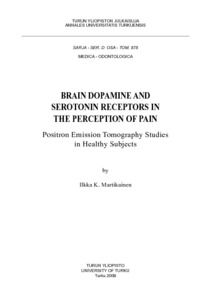Brain Dopamine and Serotonin Receptors in the Perception of Pain. Positron Emission Tomography Studies in Healthy Subjects
Martikainen, Ilkka K. (2009-12-04)
Brain Dopamine and Serotonin Receptors in the Perception of Pain. Positron Emission Tomography Studies in Healthy Subjects
Martikainen, Ilkka K.
(04.12.2009)
Turun yliopisto
Julkaisun pysyvä osoite on:
https://urn.fi/URN:ISBN:978-951-29-4093-6
https://urn.fi/URN:ISBN:978-951-29-4093-6
Kuvaus
Siirretty Doriasta
ei tietoa saavutettavuudesta
ei tietoa saavutettavuudesta
Tiivistelmä
The role of dopamine and serotonin in spinal pain regulation is well established. However, little is known concerning the role of brain dopamine and serotonin in the perception of pain in humans.
The aim of this study was to assess the potential role of brain dopamine and serotonin in determining experimental pain sensitivity in humans using positron emission tomography (PET) and psychophysical methods. A total of 39 healthy subjects participated in the study, and PET imaging was performed to assess brain dopamine D2/D3 and serotonin 5-HT1A receptor availability. In a separate session, sensitivity to pain and touch was assessed with traditional psychophysical methods, allowing the evaluation of potential associations between D2/D3 and 5-HT1A binding and psychophysical responses. The subjects’ responses were also analyzed according to Signal Detection Theory, which enables separate assessment of the subject’s discriminative capacity (sensory factor) and response criterion (non-sensory factor).
The study found that the D2/D3 receptor binding in the right putamen was inversely correlated with pain threshold and response criterion. 5-HT1A binding in cingulate cortex, inferior temporal gyrus and medial prefrontal cortex was inversely correlated with discriminative capacity for touch. Additionally, the response criterion for pain and intensity rating of suprathreshold pain were inversely correlated with 5-HT1A binding in multiple brain areas.
The results suggest that brain D2/D3 receptors and 5-HT1A receptors modulate sensitivity to pain and that the pain modulatory effects may, at least partly, be attributed to influences on the response criterion. 5-HT1A receptors are also involved in the regulation of touch by having an effect on discriminative capacity.
The aim of this study was to assess the potential role of brain dopamine and serotonin in determining experimental pain sensitivity in humans using positron emission tomography (PET) and psychophysical methods. A total of 39 healthy subjects participated in the study, and PET imaging was performed to assess brain dopamine D2/D3 and serotonin 5-HT1A receptor availability. In a separate session, sensitivity to pain and touch was assessed with traditional psychophysical methods, allowing the evaluation of potential associations between D2/D3 and 5-HT1A binding and psychophysical responses. The subjects’ responses were also analyzed according to Signal Detection Theory, which enables separate assessment of the subject’s discriminative capacity (sensory factor) and response criterion (non-sensory factor).
The study found that the D2/D3 receptor binding in the right putamen was inversely correlated with pain threshold and response criterion. 5-HT1A binding in cingulate cortex, inferior temporal gyrus and medial prefrontal cortex was inversely correlated with discriminative capacity for touch. Additionally, the response criterion for pain and intensity rating of suprathreshold pain were inversely correlated with 5-HT1A binding in multiple brain areas.
The results suggest that brain D2/D3 receptors and 5-HT1A receptors modulate sensitivity to pain and that the pain modulatory effects may, at least partly, be attributed to influences on the response criterion. 5-HT1A receptors are also involved in the regulation of touch by having an effect on discriminative capacity.
Kokoelmat
- Väitöskirjat [3019]
